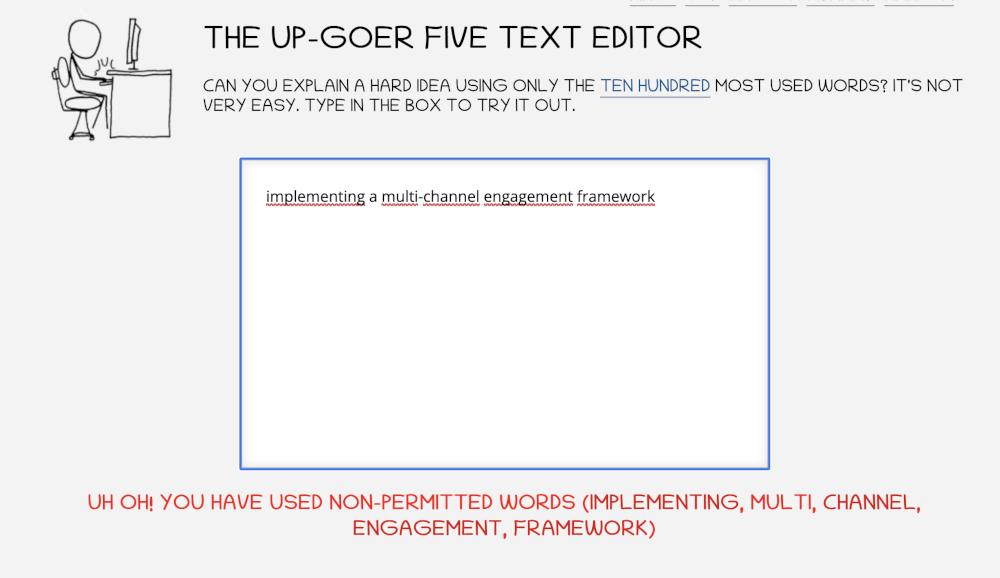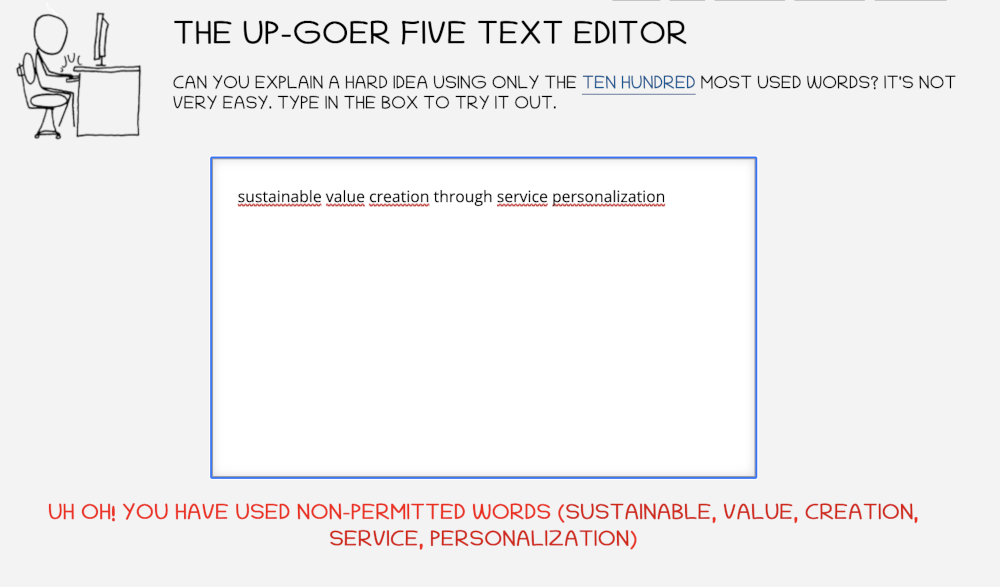How to eliminate the jargon from your strategy deck
A rocket launches skyward, surrounded by fire and smoke.
Last week, we shared our tips for communicating your business strategy in a way that’s clear, simple and likely to inspire your employees to action.
But explaining your strategy in clear, simple language is easier said than done. What’s more, the more time you spend talking about your strategy with your senior team, the harder it gets to explain to those outside the inner circle.
It’s called the expert trap or “the curse of knowledge”. In other words, the phenomenon that the more you know about a topic, the harder it is to imagine not knowing what you know.
That’s a problem because your strategy should be a blueprint: a set of easy-to-follow, step-by-step instructions that anyone in the org can follow.
Now, given the origins of our name, you won’t be surprised to learn that one of our favourite sources of inspiration for a blueprint is the space-inspired Up Goer Five.
This cute, playful blueprint for building a rocket labels each part of the construction using only the thousand most common words in English.
For example, the command module becomes the “people box”, Oxygen becomes “breathing type air”.
There’s even a tool that goes along with the blueprint that invites you to explain a hard idea using only the thousand most common words.
This tool has a powerful — if chastening — effect on any jargon-addicted exec who dares to use it. We highly recommend running your strategy deck through it before sharing that deck with your employees.
For example, let’s say you’ve decided one element of your strategy involves "implementing a multi-channel engagement framework”. Pop that phrase in the tool and here’s what you get:
Screenshot of Up-Goer Five tool, showing “implementing a multi-channel engagement framework”. Tool says: “Uh oh! You have used non-permitted words (implementing, multi, channel, engagement, framework)
Yep, every word except “a” doesn’t make the cut. But this result forces us to think about what the phrase actually means. How about something shorter and more concrete like “give people lots of different ways to get in touch with us”.
Congratulations! Every word in that translation is allowed.
Screenshot of Up-Goer Five tool, showing “give people lots of different ways to get in touch with us”. Tool says: “Congratulations! You have used only the ten hundred most common words.”
Now, which of these two versions of the strategy do you think employees will respond to better? Which could they imagine themselves contributing to? Which will get them most excited?
“Implementing multi-channel engagement frameworks”? Or “giving people lots of different ways to get in touch with us”?
Let’s try another phrase. Let’s imagine another aspect of your strategy is “sustainable value creation through service personalization.” Again, the Up Goer Five tool flags all but one word.
Screenshot of Up-Goer Five tool, showing “sustainable value creation through service personalization”. Tool says: “Uh oh! You have used non-permitted words (sustainable, value, creation, service, personalization)”
This phrase is, perhaps, harder to translate using the 1,000 most common words. But maybe we could try something like “make people love us by being nice to them”.
Screenshot of Up-Goer Five tool, showing “make people love us by being nice to them”. Tool says: “Congratulations! You have used only the ten hundred most common words.”
Once again, the tool says “yes”!
You may feel that “make people love us by being nice to them” is too extreme in its simplicity to include in your strategy deck. And perhaps you feel “nice” lacks the specificity of “service personalization”.
But then perhaps that simple language is the starting point for thinking differently — and more emotively — about your customers. Maybe the final language you land on is somewhere between the two extremes?
Again, picture that customer service rep on a call with a customer. Which do you think is going to inspire them to deliver the kind of service that wins over hearts and minds? Which has the power to change your whole culture for the better?
Want help articulating your strategy in a way that inspires employees to action? Get in touch!





